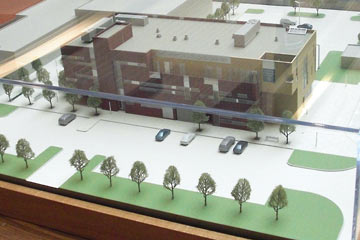AUGUST 26, 2010
What's wrong with this picture?
 Here, proudly displayed in a plexiglas case in our Student Services building, is an architectural model of a new Cuyahoga Community College building in Brunswick, Ohio.
Here, proudly displayed in a plexiglas case in our Student Services building, is an architectural model of a new Cuyahoga Community College building in Brunswick, Ohio.
A colorful 3-page handout we got at our recent Convocation day showed this $10.2 million building along with four others. The total budget for all of these facilities scheduled to open between October 2010 and January 2012: $76,400,000.
$76 million is a lot of money. What do we get for it?
More space. With a 30% enrollment increase this semester that follows a 20% increase the semester before of course we need more space. Can't disagree with that.
Energy-efficiency. All of Tri-C's new buildings aim at LEED Silver certification, meaning they'll save a lot of energy and money. And I like shiny new energy-efficient buildings as much as the next guy. But...
Let me be honest: I have a horse in this race. As a full time faculty member at Tri-C who just got his ten-year service award, I think faculty are pretty important. But still, I dare say that most people, if they had to choose between great faculty and great buildings, would make faculty their top priority. After all, the faculty are the ones who actually meet, work with, counsel, and teach the students. At a convocation day a few years back our associate dean went so far as to say that we (faculty) were the college. I didn't believe it even then, but still appreciated the thought.
Times have changed
An email today from my campus president says:
"As you know, all vacant faculty positions are refilled, but not necessarily within the same department or at the same campus."
In other words, we lose a Visual Communication faculty person at West and maybe an Math teacher gets hired at East. Gee, now I feel better.
Updated 8/27/10
Back in the good ol' days when we were the college, our Visual Communication & Design department had eight, maybe nine full time faculty members. Now we have four. We've lost faculty by attrition— mostly retirement—and they are not replaced. The college says there's no money in the budget. In light of the enrollment increases, does this make sense?
With fewer full timers and more students, we rely more and more on adjunct faculty to teach all those students streaming through our doors.
Adjunct (part-time) faculty are a wonderful supplement to the college's full time faculty. We have great adjuncts who work very hard for not a lot of money. We literally couldn't survive without them. But there are limits to what they can do. As researcher David A. Berry points out:
Part-time faculty are excellent instructors, but they are not integrated into the ongoing activities of the full-time faculty and the life of the institution...Part-time faculty are not available to students for the personal, "open-door" accessibility of community college faculty or for academic advising. At the same time, full-time faculty experience increased work pressures fulfilling the normal functions of their academic departments and college committees. Burdened faculty have less time to advise and consult with students. Everyone loses.
Priorities
It's no mystery why colleges all over the country are hiring more adjuncts and fewer full time faculty: it's a whole lot cheaper.
At Tri-C an adjunct instructor is paid $795 per ESU. An ESU is roughly equivalent to a credit hour, but it varies with the type of course. A full time teaching load is 30 ESUs per year. So, if an adjunct taught the same amount as a full time instructor he or she would make about $24,000 a year. Actually they are limited to fewer ESUs than that.
There are a number of issues I'd like to get into here, including whether this is fair to the adjuncts, whether it benefits the students, and how it affects the full timers who have to spread themselves even thinner to counsel students, work on committees, develop/revise curriculum, etc. But that will have to wait for another day.
For now I want to avoid the complex issues and stick to the simple one: why is the college spending tens of millions of dollars on shiny new buildings (oh, and adding administrative staff, yet another issue) while at the same time claiming there's no money to replace retiring faculty, let alone hire new ones? Who benefits from this choice?
There's the old saying "Follow the money." If we follow the 76 million, where does it lead? Honestly, I don't know. I don't understand why buildings are more important than people.
Does it lead to student success, the mantra we've been told to chant? Does it lead to better grades, higher retention, or higher graduation rates? I'd like to see the data. There's no doubt that the average student would prefer a bright, comfortable classroom in a conveniently located building, heck, I'd prefer that too. But I doubt that even the most cynical student would choose new building over investing in great faculty.
So, you know my opinion. I'm interested in yours. Click "Share this article" to send it to friends, and/or click "Comments" to say if this building-mania makes more sense to you than it does to me.
